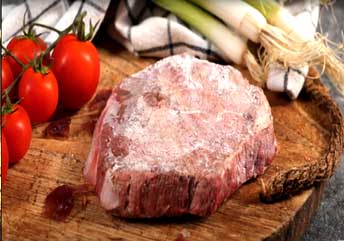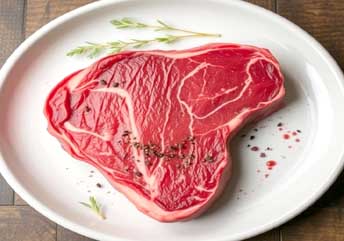You open your fridge, excited for that juicy steak dinner, but something seems off. Is it safe to cook, or should you toss it? Every year, millions of people face this dilemma, and ignoring the signs can lead to serious health issues.
In fact, foodborne illnesses affect about 48 million Americans annually, with spoiled meat as a common culprit. This guide empowers you to spot bad steak quickly, avoid risks, and store it right. Let’s dive in so you feel confident next time.
Table of Contents
ToggleWhy You Need to Know If Steak Has Gone Bad: The Importance of Food Safety
First, understand why checking steak matters. Spoiled steak harbors harmful bacteria that multiply fast in improper conditions. You risk food poisoning, which hits hard with nausea, vomiting, and worse. However, catching spoilage early prevents this entirely.
Moreover, wasting good steak costs money—Americans throw out billions in food yearly due to confusion over safety. Therefore, learning these signs saves your health and wallet.
Additionally, food safety builds trust in your meals. For instance, families in the USA, Canada, and Europe often grill steaks for gatherings, but one bad batch ruins the fun. Consequently, this knowledge protects loved ones.
Furthermore, with rising grocery prices in 2025, you want every purchase to last. So, prioritize these checks to enjoy steak worry-free. Now, move to the core method that makes detection easy.
The 3-Step Sense Check: How to Tell if Steak is Bad
You rely on your senses for this simple process. Sight, smell, and touch reveal spoilage clearly. Start with visuals, then sniff, and finally touch if needed. This method works for raw or cooked steak, though focus here on raw.
Importantly, always wash hands after handling to avoid cross-contamination.
What Does Bad Steak Look Like? Visual Signs of Spoilage
You spot bad steak first with your eyes. Fresh steak shines bright red or pink, depending on the cut. However, spoilage changes this dramatically.
For example, the color shifts to dull brown, gray, or even greenish hues as bacteria break down the meat. Additionally, look for a slimy film on the surface—this shiny layer signals bacterial growth.
Moreover, check edges for curling or yellowing, which indicate advanced decay. In contrast, fresh steak appears firm and uniform. To illustrate, compare these images of good versus bad steak.
Furthermore, mold spots—fuzzy white or green patches—mean immediate discard. However, some browning from air exposure differs from spoilage, as we’ll cover later. Therefore, combine this visual check with others for certainty. Now, transition to the next sense, which often confirms your suspicions.
What Does Bad Steak Smell Like? The Smell Test
Your nose detects spoilage reliably. Fresh steak carries a mild, neutral meaty scent—nothing overpowering. However, bad steak emits a sharp, sour odor that repels you instantly. Some describe it as ammonia-like or rotten eggs, from bacterial byproducts. Consequently, if it smells off, trust that instinct and throw it out.

Additionally, the smell intensifies when you open the package. For vacuum-sealed steak, a brief funky whiff might fade, but persistent sourness means trouble.
In comparison, good steak won’t make you gag. Moreover, this test works even if the steak looks okay, as odor reveals hidden issues. So, always sniff before cooking. Next, feel the texture to seal the deal.
What Does Bad Steak Feel Like? The Touch Test
You confirm with touch last, after washing hands. Good steak feels firm yet slightly springy, with natural moisture. However, bad steak turns sticky, tacky, or outright slimy from bacterial biofilm. This slime sticks to your fingers unpleasantly.
Furthermore, press gently—if it feels mushy or leaves an indent, spoilage has set in. In contrast, fresh steak bounces back. Additionally, avoid tasting questionable meat; senses suffice. Therefore, if two or more signs appear, discard it safely. Now, understand why this matters by exploring the risks.
What Happens If You Eat Bad Steak? Understanding the Risks
Eating bad steak invites trouble. Bacteria thrive in spoiled meat, leading to illness. However, knowledge reduces fear. First, grasp the dangers, then know when to seek help.
The Dangers of Foodborne Illness
Common bacteria like E. coli, Salmonella, and Listeria lurk in bad steak. These cause symptoms such as stomach cramps, vomiting, diarrhea, and fever, starting hours or days after eating. For example, Salmonella from undercooked or spoiled meat triggers intense nausea.
Moreover, toxins from bacteria like Staphylococcus aureus resist cooking, so heating doesn’t always help. Consequently, you suffer even if the steak tastes fine. Additionally, vulnerable groups—kids, elderly, pregnant people—face severe complications like dehydration or hospitalization. Therefore, prevention beats cure. But if symptoms hit, act fast.
When to Seek Medical Help
Monitor symptoms closely. Seek care if vomiting lasts over a day, fever spikes above 102°F, or you spot blood in stools. For adults, persistent weakness or dizziness signals dehydration—drink fluids, but see a doctor if it worsens.
Furthermore, children need quicker attention; call if they seem lethargic or urinate little. In emergencies, like blurred vision or paralysis, head to ER—these indicate botulism, rare but serious. So, err on caution’s side. Now, prevent issues by storing steak properly.
How to Properly Store Steak to Prevent Spoilage
You extend steak’s life with smart storage. Proper methods halt bacterial growth, keeping it fresh. Start in the fridge, then consider freezing for longer.
Storing Raw Steak in the Fridge
Place raw steak in the coldest fridge spot, below 40°F. USDA advises using within 3-5 days for roasts and steaks. However, ground beef lasts 1-2 days due to more surface area.
Additionally, keep it in original packaging or wrap loosely in paper to absorb moisture. Avoid tight plastic, which traps bacteria. Moreover, store on the bottom shelf to prevent drips contaminating other foods. Consequently, check dates and use FIFO—first in, first out. For visuals, see this infographic on spoilage prevention.
Freezing Steak for Long-Term Storage
Freeze steak for 4-12 months at 0°F or below. First, wrap tightly in plastic, then foil or freezer bags to block air and prevent burn.
Furthermore, vacuum-seal for best results—it removes oxygen, extending quality. Label with dates to track. Thaw in fridge overnight, not counter, to avoid bacteria. Therefore, freezing saves money on bulk buys. Now, clear up common mix-ups.
Common Confusions: When is Steak Still Safe to Eat?
You often worry over harmless changes. Distinguish real spoilage from normal shifts to avoid waste.
Is Steak Bad if it Turns Brown?
Not always. Browning stems from oxidation, like an apple turning brown—air reacts with meat pigments. If it smells fine and feels firm, cook it safely.
However, if brown accompanies slime or sour smell, it’s spoiled. Additionally, check the whole piece; surface brown might be okay if inside stays red. Therefore, use multiple senses. For comparison, view this image.
Is it Safe to Eat Steak That Smells a Little Funny?
No—err safe. A “funny” smell indicates early spoilage; don’t risk it. Cooking won’t eliminate all toxins.
Moreover, your nose evolved to detect this for survival. Consequently, toss if doubtful. Better safe than sorry.
Freezer Burn vs. Spoilage
Freezer burn shows dry, grayish spots from moisture loss—it’s safe but tastes bland. Trim affected areas and cook.
However, spoilage involves slime or odor, unlike burn’s texture issue. Therefore, distinguish to salvage meat. Now, answer more questions.
Frequently Asked Questions About Bad Steak
You ask these often—here’s clear info.
How long does it take for steak to go bad in the fridge?
Raw steak lasts 3-5 days at 40°F or below. Factors like packaging affect this; vacuum-sealed extends it.
Can you get sick from eating steak that’s a little off?
Yes, even mild spoilage harbors bacteria causing illness. Symptoms include cramps and vomiting.
Does cooking bad steak make it safe?
No—cooking kills some bacteria but not toxins. Discard spoiled meat.
How do I thaw frozen steak safely?
Thaw in fridge or cold water, not room temp, to prevent bacteria.
What if my steak has a sell-by date passed?
Sell-by guides stores; use within 3-5 days post-purchase if stored right.
Can I refreeze thawed steak?
Yes, if thawed in fridge and not spoiled, but quality drops.
Why does steak smell after freezing?
Freezer odors absorb; wrap better next time.
Is green tint on steak dangerous?
Yes, indicates bacterial growth—toss it.
How to prevent slime on steak?
Store cold, dry surfaces, and use promptly.
What apps track food freshness?
Try USDA’s FoodKeeper for guidelines.
In summary, you now spot bad steak confidently. Apply these tips to stay safe and reduce waste. What’s your biggest food safety worry? Share below—I respond personally. For more, subscribe or check related guides on nutrition.
Some Useful Resources and References:
The following sources provide science-backed insights on identifying spoilage through visual signs, odors, textures, and proper storage methods, ensuring alignment with the food safety focus of the blog. Each reference includes the website post address, a brief explanation of its relevance, and why it’s trustworthy.
First Video about How to Tell if Beef is Spoiled
Next Video about How to tell if Steak is Bad
Another Video about How can I tell if my Meat’s gone Bad?
Next Video Herer’s How to Tell if Chiceken has gone Bad
Final Video about How to tell if Steak is Bad or Spoiled
-
USDA: Does the Color of Beef Indicate Freshness?
This USDA guide explains why beef, including steak, turns brown due to oxidation versus spoilage. It emphasizes checking for off-odors or sliminess to confirm if steak is bad. As a U.S. government authority, USDA’s expertise ensures reliable food safety advice.
Website Post Address: https://ask.usda.gov/s/article/Does-the-color-of-beef-indicate-freshness
Why Trustworthy: USDA is a leading authority on food safety, backed by rigorous scientific standards and regulatory oversight.
-
Mayo Clinic: Food Poisoning Symptoms and Causes
Mayo Clinic details how spoiled steak can harbor bacteria like Salmonella, causing symptoms like vomiting or cramps. It’s perfect for understanding the health risks of bad steak. Their medical expertise makes this a go-to for YMYL content.
Website Post Address: https://www.mayoclinic.org/diseases-conditions/food-poisoning/symptoms-causes/syc-20356230
Why Trustworthy: Mayo Clinic is a globally recognized medical institution with peer-reviewed, expert-driven health content.
-
Cleveland Clinic: Has My Ground Beef Gone Bad?
This article applies to steak, highlighting rancid smells and slimy textures as spoilage signs. It advises trusting your senses over dates, making it practical for home cooks. Cleveland Clinic’s health focus ensures credibility.
Website Post Address: https://health.clevelandclinic.org/how-to-tell-if-ground-beef-is-bad
Why Trustworthy: Cleveland Clinic is a top-tier medical center with authoritative, doctor-vetted content.
-
FDA: Intact Steak Decision-Tree for Food Establishments
This FDA PDF offers a decision tree for spotting spoiled steak, focusing on texture and smell. It’s ideal for both professionals and consumers to ensure safety. The FDA’s regulatory role cements its trust factor.
Website Post Address: https://www.fda.gov/media/163808/download
Why Trustworthy: The FDA sets U.S. food safety standards, providing precise, science-based guidelines.
-
USDA: Protecting Your Family from Food Spoilage
This USDA blog covers spoilage signs like color changes and mold in meats like steak, plus fridge storage tips. It’s family-focused, making it relatable and actionable.
Website Post Address: https://www.usda.gov/about-usda/news/blog/protecting-your-family-food-spoilage
Why Trustworthy: USDA’s government-backed expertise ensures accurate, up-to-date food safety advice.
-
Consumer Reports: Why Is Ground Beef Making People Sick?
While focused on ground beef, this applies to steak, stressing sensory checks (smell, feel) over appearance alone. It’s great for avoiding foodborne illness. Consumer Reports’ independent testing adds authority.
Website Post Address: https://www.consumerreports.org/food-safety/why-is-ground-beef-making-people-sick/
Why Trustworthy: Consumer Reports is a respected nonprofit known for unbiased, evidence-based consumer guidance.
-
Michigan State University Extension: The Color of Meat Depends on Myoglobin
This academic source explains why steak browns (myoglobin oxidation) and how to distinguish it from spoilage using smell and touch. It’s a clear, science-driven resource.
Website Post Address: https://www.canr.msu.edu/news/the_color_of_meat_depends_on_myoglobin_part_1
Why Trustworthy: MSU Extension is a reputable academic source with expert-led food science education.
-
CDC: Symptoms of Food Poisoning
The CDC outlines symptoms like diarrhea from eating spoiled steak and offers prevention tips like proper refrigeration. It’s critical for understanding health impacts.
Website Post Address: https://www.cdc.gov/food-safety/signs-symptoms/index.html
Why Trustworthy: The CDC is a global leader in public health, providing authoritative, data-driven advice.
-
WebMD: What You Should Know About Food Poisoning
WebMD explains how slimy or off-smelling steak can lead to illness, even if cooked. It includes safe storage temps, aligning with the blog’s prevention tips.
Website Post Address: https://www.webmd.com/food-recipes/food-poisoning/food-poisoning-diagnosis
Why Trustworthy: WebMD collaborates with medical experts to deliver accessible, vetted health content.
-
Harvard Health: What Do Food Freshness Labels Really Mean?
Harvard clarifies that sell-by dates on steak don’t always mean spoilage, urging sensory checks for odor and texture. It helps reduce food waste safely.
Website Post Address: https://www.health.harvard.edu/staying-healthy/what-do-food-freshness-labels-really-mean
Why Trustworthy: Harvard Health is a globally respected source for evidence-based health and nutrition insights.
These references—from government agencies (USDA, FDA, CDC), top medical institutions (Mayo, Cleveland, Harvard), and trusted organizations (Consumer Reports, MSU)—directly support the blog’s focus on identifying bad steak through sight, smell, touch, and storage best practices.
Let me know your top pick in the comments, and I’ll break it down further. Keep your meals safe and delicious!





